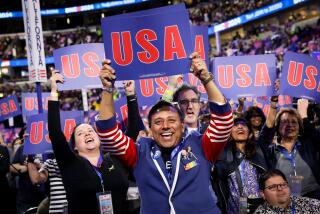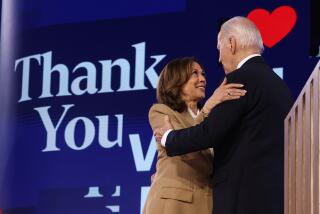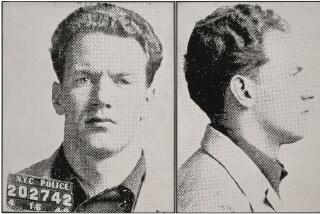A Bush buss is more than a kiss
NEW YORK — The hug (however casual) and the kiss (usually just a peck) are so much a part of a presidential candidate’s repertory of gestures that they barely register (unless, of course, you are the recipient). But after public displays of affection like Al Gore’s overlong stagy smooching with Tipper at the 2000 Democratic National Convention, and that weirdly awkward hug that Sen. John McCain gave President Bush recently in Florida, you can hardly help wondering what the participants were really thinking.
As part of the extensive Imagine Festival of Arts, Issues and Ideas taking place around New York City this week, there could be found closer examinations of the kiss and the hug. At a small, out-of-the-way gallery in the Williamsburg section of Brooklyn, Rachel Mason’s “Kissing President Bush” depicts the artist romantically locking lips with her commander in chief. At the Asia Society in Manhattan on Saturday night, the avant-garde dance team Eiko and Koma performed their 1984 “Mourning,” in which they appear naked and ever so slowly intertwine.
Mason’s beautifully made white sculpture takes you aback. It’s a close-up depiction of the president, wearing a jacket and tie, fervently kissing Mason, who looks carried away. We’ve never seen Bush like that in a public pose, yet there he is, and carved in stone, no less. It’s nearly impossible to take your eyes off a work that presumes to show us what the presidential kisses are actually like, because it makes you feel as if you are seeing him for the first time.
In “Mourning,” the chalky white Eiko and Koma, first seen lying separately onstage, gradually reach for each other as the dancers appear to laboriously move one muscle at a time. First, half a buttock rises, then maybe a finger. It takes forever for these grotesque shapes to appear human and touch. Eventually they embrace and then just as slowly roll apart. The whole process takes about half an hour, as bland electronic music drones louder, then softer again. The dancers’ bodies appear to be putty in nature’s hands, which is to say they achieve one grim hug.
Striking images from Iraq
Presidential campaigns are unequaled when it comes to extravagant displays of ego. Just think what kind of raw ambition it takes to get up in front of the country, day after day, and tell the people that you, and you alone, are best qualified to be the most powerful person in the world. And such egotism is contagious. With a town full of pols and protesters, it sometimes feels that half of New York at any given moment is trying to figure out how to get on television.
That is what makes “Photographs by Iraqi Civilians,” at the New York University Tisch School of the Arts, so striking. Last April and May, as part of a project aimed at creating new forms of documentary, the Daylight Community Arts Foundation provided 10 ordinary Iraqis with cameras and asked them to reveal the Iraq they knew. Here is a show that, at last, is not about us, but about them.
Some pictures expose scenes of devastation, such as a family that, along with 500 others, lives in a garbage dump. But the children still play, and life goes on. At a makeshift beauty parlor, a young man submits to, of all things, a facial. Neither bombs nor fundamentalists are a match for metrosexual tenacity.
Five-minute tales
At the Bitter End on Monday night, a so-called story slam took another approach to art and ego. Six names were drawn from a hat. Each contestant then got up and told a story that had to last five minutes and no more. Notes were not allowed, but the stories were required to be well-constructed and on the theme of the squeaky wheel -- the tie-in with Imagine. Lewis H. Lapham, editor of Harper’s, got the ball rolling as a special noncompeting guest, talking about his grandfather, who was a mayor of San Francisco in the ‘40s and once staged a race between an elephant and a streetcar. (The elephant won.)
The contestants were mostly funny and all impressive, and all stayed on message. Even when the stories veered into stand-up comedy, classical structure was retained. The winner, who was funny and touching, managed to get in a surprising amount of nuance as he described how fighting for what you want can be self-defeating. Though intensely personal, his story got its power from its tight discipline. Long-winded politicians could learn much from such exercises.
More to Read
The biggest entertainment stories
Get our big stories about Hollywood, film, television, music, arts, culture and more right in your inbox as soon as they publish.
You may occasionally receive promotional content from the Los Angeles Times.











